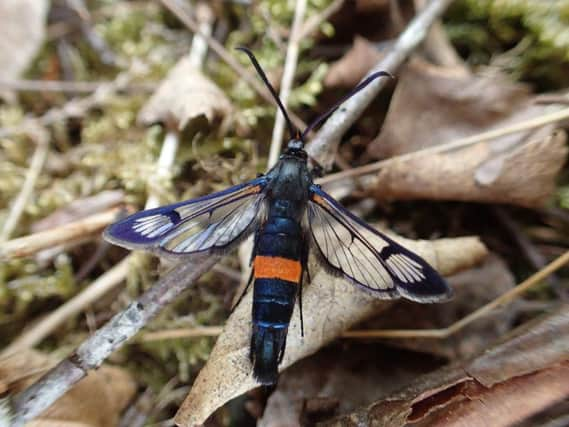Our persistence pays off as the elusive Clearwings eventually come into focus


Of 16 British species, only six have been reported in Scotland. Their caterpillars are wood-boring in stems of trees and shrubs, and most are specific to a one or only a few host species.
In 2013 we first found signs of Clearwings in our woodland at Spottiswoode, when we found two hatched, empty pupal cases on stumps of birch trees we had thinned over a year earlier.
Advertisement
Hide AdAdvertisement
Hide AdA moth expert identified them from photographs as pupae of the Large Red-belted Clearwing, whose caterpillars feed inside birch stumps. This species is currently not known anywhere else in southern Scotland, although there is an old record from Lauder in 1902.
Over the next three years we tried very hard, but failed to spot these secretive insects, though 14 more pupae were found at the end of May 2015 on some birch stumps around an open area of heather. But we were too late – the insects had already hatched and flown off.
We decided to redouble our efforts and the following winter cut down more birch trees. These had been naturally regenerating in abundance following removal of the Sitka Spruce trees as part of our woodland restoration project.
The following May (2016) we still could not find any Clearwings, but the adult moths must have hatched and been flying and laying their eggs on the cut stumps because a year later, in May 2017, we finally managed to see a few of the adults flying around.
Advertisement
Hide AdAdvertisement
Hide AdThis year we decided to try even harder, and were fortunate to get a spell of warm sunny weather in late May. By patiently sitting day after day in the area of felled trees, we managed to see and photograph several adults busily laying their eggs on recently-cut stumps. We even witnessed one adult hatching from a stump and leaving its empty pupal case behind in the hole the caterpillar had made.
The moths were surprisingly tame and totally preoccupied with visiting stumps and laying their eggs. A count of empty pupae gave a total of 82, which means that we must now have built up quite a large population of these insects locally
Our plan is to cut down a few more birch trees each winter, in the hope of keeping this rare species happy by providing new habitat every year. However, there is still a mystery. What do the insects do when there are no birch stumps around? Lay their eggs on living birch trees?